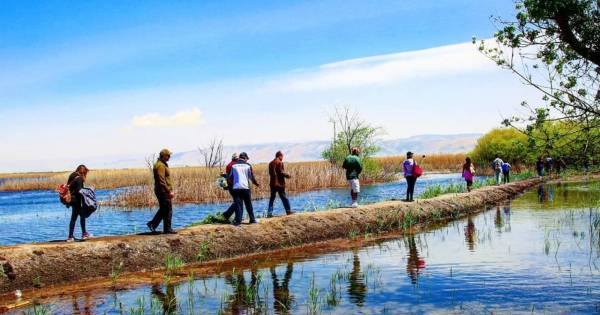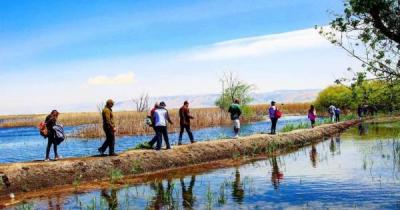The iron duck glides through sparkling wetlands, as a flock of migratory birds rises, guarded by colorful butterflies that accompany swarms of bees and various amphibians and reptiles in a natural reserve in the Ammiq plain in eastern Lebanon, maintaining its moisture despite the arid climate and global warming.
The Ammiq Reserve isolates its environmental wealth from other natural battles after the Middle East has been affected by climate change over the past few years, leading to rising temperatures and irregular rainfall. The Bekaa plain and neighboring Syria have suffered from heatwaves and drought, resulting in forest fires and diminished crop yields. The Ammiq marshes are among the largest wetlands in Lebanon, containing remnants of marshes and lakes that once existed in the Bekaa Valley. In 1994, it was classified as a rare bird area by the Global Bird Association. In 2005, UNESCO designated it along with the Shouf Cedar Reserve as a "Biosphere Reserve."
Agricultural engineer and wetlands manager at Ammiq, Abdallah Hanna, says this area "attracts biodiversity where birds pass frequently and regularly... We can work more so that we can conserve water and not lose it to keep the area moist and retain green cover." Hanna tells Reuters about the importance of building dams to retain water as long as possible during summer, stating, "The dam project started in 2014 and ended in 2016, and we were able to preserve four to five million cubic meters of water that allowed us to see water here, even though this year is considered the worst not only for Lebanon but for the entire world concerning global warming and climate change and drought worldwide."
Hanna explained that internal water springs enrich the marshes, and the dams helped retain water, providing a refreshing swim for the buffalo herd daily. He added, "We are approaching September, and the area is still green, with good amounts of water remaining." He clarified that every five square kilometers of forest is equivalent to one kilometer of wetlands in its ability to absorb carbon dioxide.
### Biodiversity
Ammiq is home to over 260 bird species, with patrols conducted to ensure no poaching occurs. The reserve contains mountains and water springs and rivers housing hundreds of plant species and trees, serving as a habitat for mammals, amphibians, and reptiles. Lebanon is one of the major migratory bird pathways in the world, where hundreds of millions migrate from Africa to Europe and Asia every spring, with some stopping for hours and others for weeks until wind and temperature conditions are optimal for travel.
### Green Cover
The green cover in the reserve spans 27 million square feet and is privately owned by the Skaf family of Lebanon. One landowner, Myriam Skaf, stated that Ammiq is "a legacy from our ancestors" for a hundred years, and she and her family are entrusted with this heritage "and I will not let it fade away; we are the guardians of this natural structure." She added to Reuters, "The lack of government interest due to poor economic conditions does not deter us from our role in protecting a reserve that attracts the world and has become a haven for capturing stunning landscapes. And if those who have left this country have emigrated, the resident birds will remind us that our land, sky, and water are rare treasures."
Among the bird species recorded in the area are the greater spotted eagle, the eastern imperial eagle, and the lesser kestrel. The records include endangered species such as the great snipe, the iron duck, and the pallid harrier, which is a type of raptor. Five amphibian species and twelve reptile species have also been recorded. More than 50 butterfly species have been found in the area through a two-year survey.
### Wetland
The wetlands are located seven kilometers southwest of Qab Elias city on the eastern slope of Mount Lebanon. The main area, consisting of reeds and open ponds, covers 253 hectares and extends eastward from the slopes of the mountains to the Litani River in a long strip. Rain and snow falling on the top of Mount Barouk in the west provide water for the wetlands.




